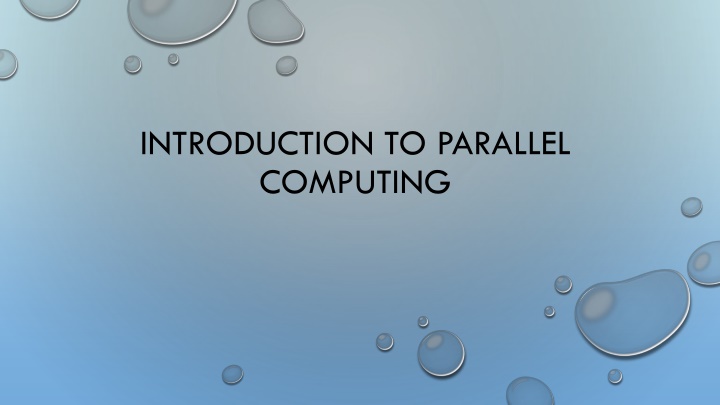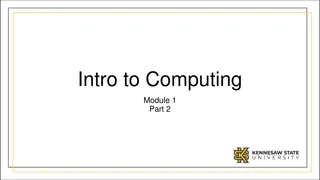
Introduction to Parallel Computing and Parallel Computers
Explore the world of parallel computing, where multiple processing elements collaborate to solve problems simultaneously. Learn about the key elements of parallel computers, contemporary computing systems, parallel programs, and the reasons why parallel computing is essential for large-scale applications and scientific computing. Discover the benefits of parallel computing in improving performance and efficiency in today's technologically advanced world.
Download Presentation

Please find below an Image/Link to download the presentation.
The content on the website is provided AS IS for your information and personal use only. It may not be sold, licensed, or shared on other websites without obtaining consent from the author. If you encounter any issues during the download, it is possible that the publisher has removed the file from their server.
You are allowed to download the files provided on this website for personal or commercial use, subject to the condition that they are used lawfully. All files are the property of their respective owners.
The content on the website is provided AS IS for your information and personal use only. It may not be sold, licensed, or shared on other websites without obtaining consent from the author.
E N D
Presentation Transcript
INTRODUCTION TO PARALLEL COMPUTING
Parallel Computers and Parallel Computing What is a parallel computer? o A collection of processing elements that communicate and coorperate to solve problems. o What is a processing element? Depending on the context, it can be a whole computer, a CPU, a CPU core, a GPU core, or a functional unit. o Three key elements in a parallel computer: 1. More than one processing element. More than one processing element allows computation to be performed in parallel! 2. The processing elements are connected, and can communicate with one another when needed 3. The processing elements corporate to solve problems.
Many Contemporary Computing Systems are Parallel Computers o Mobile devices, IoT devices, many have multi-core CPUs IPhone 13, A15 6 CPU cores, 16 Neural Engine cores, 4 GPU cores o Desktop or laptop, multi-core CPU o A high-end gaming computer (CPU + GPU) o Multi-core server o Linprog cluster o FSU Research Computing Center (RCC) o Cloud Computing platforms (Amazon AWS, Google cloud). o Frontier supercomputer at Oak Ridge National Laboratory (No. 1 in June 2024 , 1714.81 Peta flops per second peak performance) Uniprocessor systems Multi-processor systems In today s world, almost any computing device is a parallel computing device!
Parallel Computers and Parallel Computing Parallel computer o A collection of processing elements that communicate and coorperate to solve problems. Parallel computing o Parallel computing is a type of computation where many calculations or processes are performed simultaneously. o Parallel computing is performed on a parallel computer where multiple processing elements are utilized simultaneously. Parallel programs o Parallel programs are programs that can simultaneously utilize multiple processing elements, usually having multiple threads of execution. o Sequential programs: programs where instructions are executed in sequence.
Why parallel computing? Some large-scale applications can use any amount of computing power. o Scientific computing applications Weather simulation. More computing power means more finer granularity and prediction longer into the future. Training of large machine learning models in many domains, such as ChatGPT. In small scale, we would like our programs to run faster as the technology advances conventional sequential programs are not going to do that. o CPU frequence has stopped at around 4GHz for more than 15 years, and single threaded programs are not running much faster during this period of time. o What we see during the period is that the number of Cores in CPUs steadily increases.
A Motivating Example for Parallel Computing A parallel computing example: ChatGPT Input layer Hidden layer 1 Hidden layer 2 Hidden layer 3 Output layer o Under the hood of a large language model is a large deep neural network, which consists of layers of artificial neurons and connections between them. o Each connection is associated with a weight, each neuron is also associated with a bias. o Training of a neural network is to get to the right weights and biases such that the error across the training data is minimized.
A single neuron Activation function b (?) w1 ?1 Neuron O=sigmoid(L) (?)+ + ?? ?? (?)+b L = ?1 ?1 wm (?) ?? An artificial neuron has two components: (1) weighted sum and (2) a nonlinear activation function. 1 o Many activation functions, a commonly used one is sigmoid: ??????? ? = 1+? ?
Training of a single neuron Activation function b (?) w1 ?1 Neuron O=sigmoid(L) (?)+ + ?? ?? (?)+b L = ?1 ?1 wm (?) ?? The training problem: (0), ?2 (0), ,?0), (?1 (1), ?2 (1), ,?1), , (?1 (?), o Given a set of training data [ (?1 (?), ,??),], find the value for w1, w2, , wm and b that minimize the overall errors. ?2
Training of a single neuron Activation function b (?) w1 ?1 Neuron O=sigmoid(L) (?)+ + ?? ?? (?)+b L = ?1 ?1 wm (?) ?? 1 2(? ?)2) The training algorithm (assume error ? = o Initialize the parameters w1, , wm and b with some random number (or all 0 s) (?), ?2 Perform forward propagation: compute L, O, and E Perform backward propagation of errors: compute error in O, which is ?? w1 (?? ??1) , wm and b. Update the parameters wi = wi learning_rate * error_in_wi (?), ,??): o For each training data (?1 ??; error in L, which is ?? ??, errors in
Training for the logic AND with a single neuron In general, one neuron can be trained to realize a linear function. Logic AND function is a linear function: ?? ?? ?? ?? 0 0 0 (0, 1) (1, 1) 0 1 0 1 0 0 1 1 1 (1, 0) (0, 0) Logic AND ( ) operation
Training for the logic AND with a single neuron b=0 ?1=0 ?1=0 Sigmoid(s) O=Sigmoid(0)=0.5 ?2=0 ?2= 1 Activation function L= ?1?1+?2?2+ ? = 0 Consider training data input (?1=0, ?2= 1), output Y=0. Forward propagation: o L = ?1?1+?2?2+ ? = 0 0 + 1 0 + 0 = 0 o O = Sigmoid(L) = sigmoid (0) = 1 1 1+1 = 0.5 1+? 0= 1 2(? ?)2=1 2(0 0.5)2= 0.125 o ? =
Training for the logic AND with a single neuron b=0 ?1=0 ?1=0 Sigmoid(s) O=Sigmoid(0)=0.5 ?2=0 ?2= 1 Activation function L= ?1?1+?2?2+ ? = 0 Consider training data input (?1=0, ?2= 1), output Y=0. Backword propagation of errors: ?(1 2(? ?)2) ?? o Error in O: ?? ?? = ?? ?? = 0.5 * ?(??????? ? ) ?? ?? = O Y = 0.5 0 = 0.5 o Error in L: ?? = 0.5 * sigmoid(L) (1-sigmoid(L)) = 0.5 * 0.5 (1-0.5) = 0.125, ?? ?? ?? ??2 = 0.125 * ?(?1?1+?2?2+?) o Error in w2: ?? = 0.125 ?2 = 0.125 ?? ??2 o Error in w1=0, and error in b=0.125
Training for the logic AND with a single neuron b=0 ?1=0 ?1=0 Sigmoid(s) O=Sigmoid(0)=0.5 ?2=0 ?2= 1 Activation function L= ?1?1+?2?2+ ? = 0 Consider training data input (?1=0, ?2= 1), output Y=0. Update parameters (learning rate = 0.1) o w1 = w1 learning_rate * error_in_w1 = 0 0.1 * 0 = 0 o w2 = w2 learning_rate * error_in_w2 = 0 0.1 * 0.125 = -0.0125 o b = b learning_rate * error_in_b = 0 0.1 * 0.125 = -0.0125
Training the deep neural network has the same process as training one neuron Initialize parameters (weights and biases) with some random numbers (or all 0 s) Input layer Hidden layer 1 Hidden layer 2 Hidden layer 3 Output layer (?), ?2 (?), ,??): For each training data (?1 o Perform forward propagation to compute neural network output and error for the input o Perform backward propagation of errors: compute the error for each parameter. o Update the parameters wi = wi learning_rate * error_in_wi Time complexity for one training data input: ?
Training ChatGPT ChatGPT 4 has 1 trillion parameters. Input layer Hidden layer 1 Hidden layer 2 Hidden layer 3 Output layer The size of the training data is also huge, in trillions. Total computations? Time it takes to train ChatGPT with parallel computing: o 5-6 months with 10,000 V100 GPU.
Why parallel computing? Bigger: Solving larger problems in the same amount of time. Faster: Solving the same sized problem in a shorter time. We would not have had ChatGPT without parallel computing! o Major world powers are racing to build larger and larger supercomputers.
Classifying parallel computing systems: Flynns Taxonomy Computing is basically executing instructions that operate on data. Flynn s taxonomy classifies the system based on the parallelism in instruction stream and parallelism in data stream. o single instruction stream or multiple instruction streams. o single data stream or multiple data streams.
Flynns taxonomy Single Instruction Single Data (SISD) Single Instruction Multiple Data (SIMD) Multiple Instructions Multiple Data (MIMD) Multiple Instructions Single Data (MISD)
SISD At one time, one instruction operates on one data o Traditional sequential architecture, Von Neumann architecture.
SIMD Single control unit and multiple processing units. The control unit fetches an instruction and broadcast control to all processing units. The instruction operates on different data. o Can achieve massive processing power with minimum control logic o SIMD instructions allow for sequential reasoning.
SIMD Exploit data-level parallelism o Matrix-oriented scientific computing and deep learning applications o Media (image and sound) processing Vector machines, MMX, SSE (Streaming SIMD Extensions), AVX (Advanced Vector eXtensions), GPU
MISD Not commonly seen, no general purpose MISD computer has been built. Systolic array is one example of an MISD architecture.
MIMD Multiple instruction streams operating on multiple data streams o MIMD can be thought of as many copies of SISD machine. o Distributed memory multi-computers, shared memory multi-processors, multi-core computers.
Flynns Taxonomy Type Instruction Streams Data Streams Examples SISD 1 1 Early computers, Von Neumann architecture, turing machine SIMD 1 N Vector architectures, MMX, SSE, AVX, GPU MISD N 1 No general purpose machine, systolic array MIMD N N Multi-core, multi-processor, multi-computer, cluster
Modern classification (Sima, Fountain, Kacsuk) Based on how parallelism is achieved o Data parallelism: same function operating on many data o Function parallelism: performing many functions in parallel Control parallelism, task parallelism depending on the level of the functional parallelism. Parallel architectures Data-parallel architectures Function-parallel architectures
Functional-parallel architectures Function-parallel architectures Instruction level Parallel Arch (ILPs) Process level Parallel Arch (MIMDs) Thread level Parallel Arch Superscalar processors VLIWs Pipelined processors Shared Memory MIMD Distributed Memory MIMD
What types of (sequential) applications can be improved by parallel computing If we have an infinite number of processors, it is possible to make sequential program run much faster? A = 2; B = 4; C = 6; D = 10; A = 2; B = A + A; C = B * A; D = C+1; For(i=0; i<100000; i+= 1) a[i] = b[i] + c[i];
Dependency When two instructions operate on the same data with at least one instruction write to the data, we say that there exists data dependency between the two instructions. A = 2; B = A + A; C = b * A; D = c+1; o True dependency read after write o Output dependency write after write For(i=0; i<100000; i=+) a[i] = 0; o Anti-dependency write after read Due to the dependencies, a typical program will have a portion that can be parallelized, and the other part that cannot be parallelized.
Speedup and Scalability Let ?1 be the execution time for a computation to run on 1 processor and ?? be the execution time for the computation (with the same input same problem) to run on P processors. ?1 ?? ??????? ? = Scalability of a program measures how many processors that the program can make effective use of. o When the problem size is fixed, this is referred to as strong scaling . o When the problem size can increase with the number of processors, it is referred to as weak scaling .
Amdahls Law (fixed size speedup, strong scaling) Given a program, let f be the fraction that must be sequential and 1-f be the fraction that can be parallelized 1 ? ?1 ? ??= ? ?1+ ?1 ??= ?1 1 ??????? ? = = ? ?1+1 ? ?1 ?+(1 ?)/? ? When ? ,??????? ? = 1 ? "Validity of the Single Processor Approach to Achieving Large-Scale Computing Capabilities" "Validity of the Single Processor Approach to Achieving Large-Scale Computing Capabilities" Original paper: Amdahl, Gene M. (1967). "Validity of the Single Processor Approach to Achieving Large-Scale Computing Capabilities" . AFIPS Conference Proceedings (30): 483 485.
Amdahls law Amdahl s law: As P increases, the percentage of work in the parallel region reduces, performance is more and more dominated by the sequential region. time P=4 P=1 P=2
Question Let a program has f=10% sequential component and 90% parallel component. What is the speedup one will get with 2 processors, 5 processors and 10 processors?
Gustafsons Law (scaled speedup, weak scaling) Large scale parallel/distributed systems are expected to allow for solving problem faster or larger problems. oAmdahl s Law indicates that there is a limit on how faster it can go. oHow about bigger problems? This is what Gustafson s Law sheds lights on! In Amdahl s law, as the number of processors increases, the amount of work in each node decreases (more processors sharing the parallel part). In Gustafson s law, as the number of processors increases, the amount of work in each node remains the same (doing more work collectively).
Gustafsons law Gustafson s law: As P increases, the total work on each process remains the same. So the total work increases with P. time P=1 P=2 P=4
Gustafsons Law (scaled speedup, weak scaling) The work on each processor is 1 (f is the fraction for sequential program, (1-f) is the fraction for parallel program. With P processor (with the same ??= 1), the total amount of useful work is ? + 1 ? ?. Thus, ?1= ? + 1 ? ?. Thus, speedup(P) = ? + 1 ? ?. No of PEs Strong scaling speedup (Amdalh s law, f = 10%) Weak scaling speedup (Gustafson s law, f = 10%) 2 1.82 1.9 4 3.07 3.7 8 4.71 7.3 16 6.40 14.5 100 9.90 90.1
Implication of Gustafsons law For weak scaling, speedup(P) = ? + 1 ? ? o Speedup is now proportional to P. Scalability is much better when the problem size can increase. o Many application can use more computing power to solve larger problems Weather prediction, large deep learning models. "Reevaluating Amdahl's Law" Communications of the ACM Gustafson, John L. (May 1988). "Reevaluating Amdahl's Law". Communications of Communications of the ACM the ACM. 31 (5): 532 3.










